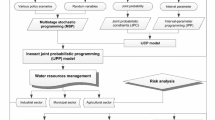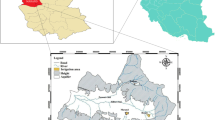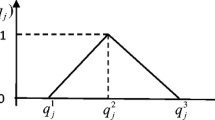Abstract
In this paper, a joint-probabilistic double-sided random interval chance-constrained programming (JDRICCP) model was proposed to deal with the random and interval uncertainties in both sides of the constraints and nodal joint probability in booster cost optimization of water distribution system (WDS). The JDRICCP model was applied to two Cases to verify the efficiency of the method on the booster cost optimization under uncertainty. After formulating the JDRICCP model, the booster costs under various violation levels based on four nodal importance measures can be obtained for two Cases. The results indicated that the booster costs are only affected by lower violation probability, and decreased with the rise of violation levels. In addition, the booster costs are closely related to the nodal importance measures. By comparing the booster costs under random interval variables and random variables, the results indicated that under random interval variables the booster costs are less than that under random variables. The results obtained can provide more information for managers to make boosters schemes under dual uncertainties of random and interval.










Similar content being viewed by others
Availability of Data and Materials
Some or all data and models supporting the findings of this study are available from the corresponding author upon reasonable requests.
References
Abhijith GR, Mohan S (2020) Random walk particle tracking embedded cellular automata model for predicting temporospatial variations of chlorine in water distribution systems. Environ Process 7:271–296
Al-Zahrani MA (2016) Optimizing dosage and location of chlorine injection in water supply networks. Arab J Sci Eng 41:4207–4215
Arjmandzadeh Z, Safi M, Nazemi A (2017) A new neural network model for solving random interval linear programming problems. Neural Networks 89:11–18
Ayvaz MT, Kentel E (2015) Identification of the best booster station network for a water distribution system. J Water Resour Plann Manag 141(5):04014076
Babayan A, Kapelan Z, Savic D, Walters G (2005) Least-cost design of water distribution networks under demand uncertainty. J Water Resour Plann Manage 131:375–382
Boccelli DL, Tryby ME, Uber JG, Rossman LA, Zierolf ML, Polycarpou MM (1998) Optimal scheduling of booster disinfection in water distribution systems. J Water Resour Plann Manage 124:99–111
Chu S, Zhang T, Zhou X, Yu T, Shao Y (2022) An efficient approach for nodal water demand estimation in large-scale water distribution systems. Water Resour Manage 36:491–505
Cimorelli L, Morlando F, Cozzolino L, D’Aniello A, Pianese D (2018) Comparison among resilience and entropy index in the optimal rehabilitation of water distribution networks under limited-budgets. Water Resour Manage 32:3997–4011
Feng J, Wu D, Gao W, Li G (2017) Uncertainty analysis for structures with hybrid random and interval parameters using mathematical programming approach. Appl Math Model 48:208–232
Goyal RV, Patel HM (2017) Optimal location and scheduling of booster chlorination stations using EPANET and PSO for drinking water distribution system. ISH J Hydraulic Eng 24:157–164
Köker E, Altan-Sakarya AB (2015) Chance constrained optimization of booster chlorination in water distribution networks. Clean - Soil, Air, Water 43:717–723
Lansey K, Pasha F, Pool S, Elshorbagy W, Uber J (2007) Locating satellite booster disinfectant stations. J Water Resour Plann Manage 133:372–376
Lu HW, Cao MF, Li J, Huang GH, He L (2015) An inexact programming approach for urban electric power systems management under random-interval-parameter uncertainty. Appl Math Model 39:1757–1768
Maheshwari A, Abokifa AA, Gudi RD, Biswas P (2018) Coordinated decentralization-based optimization of disinfectant dosing in large-scale water distribution networks. J Water Resour Plann Manag 144
Munavalli GR, Kumar MSM (2003) Optimal scheduling of multiple chlorine sources in water distribution systems. J Water Resour Plan Manag 129:493–504
Ohar Z, Ostfeld A (2014) Optimal design and operation of booster chlorination stations layout in water distribution systems. Water Res 58:209–220
Ostad-Ali-Askari K (2022) Investigation of meteorological variables on runoff archetypal using SWAT: basic concepts and fundamentals. Appl Water Sci 12
Ostfeld A, Salomons E (2006) Conjunctive optimal scheduling of pumping and booster chlorine injections in water distribution systems. Eng Optim 38:337–352
Prasad TD, Walters GA, Savic DA (2004) Booster Disinfection of Water Supply Networks: Multiobjective Approach. J Water Resour Plann Manage 130:367–376
Propato M, Uber JG (2004) Linear Least-Squares Formulation for Operation of Booster Disinfection Systems. J Water Resour Plann Manage 130:53–62
Rico-Ramireza V, Cruza FG-Dl, Iglesias-Silvaa G, Hernandez-Castrob S (2007) Optimal location of booster disinfection stations in a water distribution system: A two-stage stochastic approach. 17th European Symposium on Computer Aided Process Engineering, 231–236
Tryby ME, Boccelli DL, Uber JG, Rossman LA (2002) Facility location model for booster disinfection of water supply networks. J Water Resour Plan Manag 128:322–333
Wang Y (2021a) Inexact [Formula: see text] fuzzy chance-constrained programming of booster chlorination for water distribution system under uncertainty. Environ Monit Assess 193:300
Wang Y (2021b) Optimization of booster chlorination for water distribution system under dual uncertainties. Urban Water J 19:363–373
Wang Y, Zhu G (2022) Fuzzy credibility-constrained quadratic optimization for booster chlorination of the water distribution system under uncertainty. J Water Supply Res Technol AQUA 71:608–627
Xiaogang Q, Biwen Z, Lifang L, Shaolin H (2017) Evaluation and optimization of complex network resilience against attacks. 469–472
Funding
This work was funded by Natural Science Foundation of Jiangsu Province (Grant No. BK20191147).
Author information
Authors and Affiliations
Contributions
Yumin Wang: Study design, Methodology, Writing–review and editing.
Corresponding author
Ethics declarations
Ethics Approval
Not applicable.
Consent to Participate
Not applicable.
Consent to Publish
Not applicable.
Conflict of Interests
The authors have no conflicts of interest relevant to the content of this article. The authors have no relevant financial or non-financial interests to disclose.
Additional information
Publisher's Note
Springer Nature remains neutral with regard to jurisdictional claims in published maps and institutional affiliations.
Appendix I
Appendix I
1.1 Theorem 1
The inequity relationship \({\boldsymbol{A}}(\omega ){x}_{i}^{\pm }\le {\boldsymbol{B}}(\omega )\) is equivalent to \({{\boldsymbol{A}}}^{{\boldsymbol{L}}}(\omega ){x}_{i}^{\pm }\le {{\boldsymbol{B}}}^{{\boldsymbol{R}}}(\omega )\).
1.2 Proof
For any \(\lambda \left(0\le \lambda \le 1\right)\), we can have Eqs. (A1) and (A2) expressed as follows.
Then, for any \(\omega\) we can obtain Eqs. (A3) and (A4) expressed as follows.
Moreover, when \({x}_{i}^{\pm }\ge 0\) we can have Eq. (A5) expressed as follows.
As such, we can obtain Eq. (A6) expressed as follows.
hence, \(Pr\left\{\omega |{\boldsymbol{A}}\left(\omega \right){x}_{i}^{\pm }\le {\boldsymbol{B}}(\omega )\right\}\) can be replaced by \(Pr\left\{\omega |{A}^{L}\left(\omega \right){x}_{i}^{\pm }\le {B}^{R}(\omega )\right\},\) i.e., \({A}^{L}\left(\omega \right)\) and \({B}^{R}(\omega )\) extend the feasible sets.
1.3 Theorem 2
The inequity relationship \({\boldsymbol{A}}(\omega ){x}_{i}^{\pm }\ge {\boldsymbol{B}}(\omega )\) is equivalent to \({A}^{R}(\omega ){x}_{i}^{\pm }\ge {B}^{L}(\omega )\).
1.4 Proof
The proof of this theorem is the same as Theorem 2.
Rights and permissions
Springer Nature or its licensor (e.g. a society or other partner) holds exclusive rights to this article under a publishing agreement with the author(s) or other rightsholder(s); author self-archiving of the accepted manuscript version of this article is solely governed by the terms of such publishing agreement and applicable law.
About this article
Cite this article
Wang, Y. Joint-Probabilistic Double-Sided Random Interval Programming for Booster Optimization in Water Distribution Network. Water Resour Manage 37, 501–520 (2023). https://doi.org/10.1007/s11269-022-03383-y
Received:
Accepted:
Published:
Issue Date:
DOI: https://doi.org/10.1007/s11269-022-03383-y




